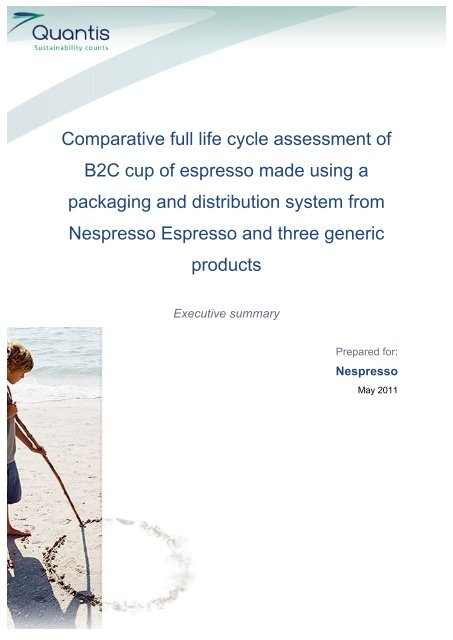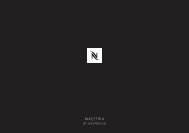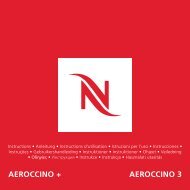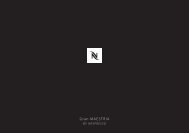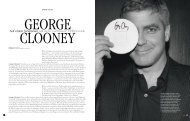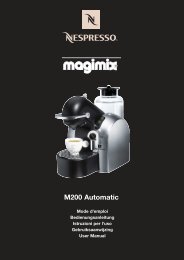Executive summary - Nespresso
Executive summary - Nespresso
Executive summary - Nespresso
Create successful ePaper yourself
Turn your PDF publications into a flip-book with our unique Google optimized e-Paper software.
Comparative full life cycle assessment of<br />
B2C cup of espresso made using a<br />
packaging and distribution system from<br />
<strong>Nespresso</strong> Espresso and three generic<br />
products<br />
<strong>Executive</strong> <strong>summary</strong><br />
Prepared for:<br />
<strong>Nespresso</strong><br />
May 2011
Comparative LCA of B2C espresso capsules<br />
This report has been prepared by Quantis, a team of world-leading experts in the field of<br />
environmental life cycle assessment. Quantis works with companies, governments and other<br />
decision makers to identify and implement the right actions for minimizing the environmental<br />
footprint of products and services. Founded in 2006, the firm maintains its global<br />
headquarters in Lausanne, Switzerland with branches in Boston, Montréal, and Paris.<br />
Quantis provides the highest level of proficiency in delivering state-of-the-art analysis and<br />
solutions for organizations striving to be leaders in the global sustainability effort.<br />
This report has been prepared by the Swiss office of Quantis. Please direct all questions<br />
regarding this report to Quantis Suisse.<br />
Quantis Suisse<br />
Parc scientifique EPFL, Bât D<br />
CH - 1015 Lausanne<br />
Suisse / Switzerland<br />
Tel: +41 21 693 91 92<br />
E-mail: info@quantis-intl.com or directly Carole Dubois, key account manager for Nestlé<br />
(carole.dubois@quantis-intl.com) or Sébastien Humbert, scientific director<br />
(sebastien.humbert@quantis-intl.com, +41-79-754-7566).<br />
Web: www.quantis-intl.com<br />
Quantis Sàrl - Parc scientifique EPFL Bât D, 1015 Lausanne, Switzerland<br />
TEL +41 (21) 693 91 92 - FAX + 41 (21) 693 91 96 | info @quantis-intl.com - www.quantis-intl.comS<br />
2
Project information<br />
Title<br />
Contracting<br />
organization<br />
Liability<br />
statement<br />
Comparative LCA of B2C espresso capsules<br />
Comparative full life cycle assessment of B2C cup of espresso using a packaging and<br />
distribution system from <strong>Nespresso</strong> Espresso and three generic products, <strong>Executive</strong><br />
<strong>summary</strong><br />
Nestlé <strong>Nespresso</strong> SA<br />
Av. De Rhodanie 40<br />
CH – 1007 Lausanne<br />
Switzerland<br />
Information contained in this report has been compiled from and/or computed from<br />
sources believed to be credible. Application of the data is strictly at the discretion and<br />
the responsibility of the reader. Quantis is not liable for any loss or damage arising from<br />
the use of the information in this document.<br />
Version 3: Final report with generic products<br />
Project team<br />
External<br />
reviewers<br />
Client<br />
contact<br />
Associated<br />
files<br />
- Carole Dubois, Key account manager for Nestlé and project manager<br />
(carole.dubois@quantis-intl.com)<br />
- Sébastien Humbert, Dr, Scientific director (sebastien.humbert@quantis-intl.com)<br />
- Manuele Margni, Dr, Internal quality control (manuele.margni@quantis-intl.com)<br />
- Michael Hauschild, Dr, Chairman, LCA expert, Technical University of Denmark,<br />
Denmark (mic@man.dtu.dk)<br />
- Bruno De Wilde, Biomaterial expert, Lab manager at Organic Waste Systems (OWS),<br />
Belgium (bruno.dewilde@ows.be)<br />
- Stéphane Arditi, Consumers expert, Policy officer on waste and products, European<br />
Environmental Bureau (EEB), Belgium (stephane.arditi@eeb.org)<br />
- Aafko Schanssema, Plastic expert, Advisor to PlasticsEurope, Belgium<br />
(aafko.schanssema@plasticseurope.org)<br />
Christophe Boussemart, Sustainable Development Project Manager<br />
Nestlé <strong>Nespresso</strong> SA<br />
Av. De Rhodanie 40<br />
CH – 1007 Lausanne<br />
+ 41 21 796 95 83<br />
christophe.boussemart@nespresso.com<br />
<strong>Executive</strong>s summaries, product per product:<br />
- NN_<strong>Executive</strong>Summary-<strong>Nespresso</strong>&Product1_EN_2011-04-31<br />
- NN_<strong>Executive</strong>Summary-<strong>Nespresso</strong>&Product2_EN_2011-04-31<br />
- NN_<strong>Executive</strong>Summary-<strong>Nespresso</strong>&Product3_EN_2011-04-31<br />
Reference flows appendix:<br />
NN_AppendixA-ReferenceFlows_2011-04-21.xls<br />
Quantis Sàrl - Parc scientifique EPFL Bât D, 1015 Lausanne, Switzerland<br />
TEL +41 (21) 693 91 92 - FAX + 41 (21) 693 91 96 | info @quantis-intl.com - www.quantis-intl.comS<br />
3
<strong>Executive</strong> <strong>summary</strong><br />
Comparative LCA of B2C espresso capsules<br />
During the year 2010, three generic espresso capsules compatible with the <strong>Nespresso</strong><br />
machines were launched in France and Switzerland, and therefore becoming a competitor to<br />
<strong>Nespresso</strong>’s own capsule. Nestlé <strong>Nespresso</strong>, wondering about the advantages and<br />
disadvantages of these products in terms of environmental impacts, has commissioned<br />
Quantis to analyze and compare the environmental profile of these four products, using the<br />
life cycle assessment (LCA) methodology, in conformity with the requirements of the<br />
international standards ISO 14040 and 14044.<br />
Goal and scope<br />
The main goal is to compare the four products to be able to answer customer questions<br />
such as: Which solution is the most environmentally friendly among the <strong>Nespresso</strong> Espresso<br />
and the alternative Espresso? What happens if I throw my capsule to the “trash”? What<br />
about if I recycle my capsule or throw it into the green wastes bin?<br />
The study compares packaging systems with specific designs and not materials.<br />
Products and system boundaries<br />
The functional unit considered for this study is To provide a 40 ml cup of espresso coffee<br />
prepared in a <strong>Nespresso</strong> machine in a business-to-consumer (B2C) environment (at<br />
home) for a Swiss and French market. The <strong>Nespresso</strong> product is made of an aluminium<br />
capsule, a portion of a sleeve and of a tertiary packaging. The generic product 1 is made of<br />
a polypropylene, aluminium and polyethylene capsule, a surpackaging, a portion of a sleeve<br />
and of a tertiary packaging. The generic product 2 is made of a polypropylene and PET<br />
capsule, a surpackaging, a portion of a sleeve and of a tertiary packaging. The generic<br />
product 3 product is made of a bioplastic capsule (mix of polylactic acid and starch), a<br />
portion of an overwrap, a portion of a sleeve and of a tertiary packaging. The analysis<br />
includes the coffee supply, the packaging, the production center, the distribution, the use<br />
and the end-of-life stages.<br />
Quantis Sàrl - Parc scientifique EPFL Bât D, 1015 Lausanne, Switzerland<br />
TEL +41 (21) 693 91 92 - FAX + 41 (21) 693 91 96 | info @quantis-intl.com - www.quantis-intl.comS<br />
4
Comparative LCA of B2C espresso capsules<br />
Table 0-1: Packaging systems studied. PP: polypropylene, PE: polyethylene, PET: polyethylene<br />
terephthalate, LDPE: low-density polyethylene, PLA: polylactic acid, SBB: solid bleached board, CB:<br />
corrugated board.<br />
Capsule<br />
Surpackaging<br />
/Overwrap<br />
“Sleeve”<br />
Tertiary<br />
packaging<br />
<strong>Nespresso</strong> Generic product 1 Generic product 2 Generic product 3<br />
Aluminium capsule<br />
Aluminium<br />
membrane<br />
Coating<br />
Total mass: ~1.1<br />
g/capsule<br />
Sleeve for 10<br />
capsules in SBB<br />
Total mass: ~1.6<br />
g/capsule<br />
Box for several<br />
sleeves in CB,<br />
LDPE film and<br />
pallet<br />
Total mass: ~0.8<br />
g/capsule<br />
PP capsule<br />
Aluminium –PE<br />
membrane<br />
Total mass: ~1.5<br />
g/capsule<br />
Surpackaging for<br />
one capsule in PEaluminium<br />
– PET<br />
laminate<br />
Total mass: ~1.6<br />
g/capsule<br />
Sleeve for 12<br />
surpackagings in<br />
SBB<br />
Total mass: ~3.7<br />
g/capsule<br />
Box for several<br />
sleeves in CB,<br />
LDPE film and<br />
pallet<br />
Total mass: ~3.3<br />
g/capsule<br />
PP capsule<br />
PET membrane<br />
Total mass: ~1.7<br />
g/capsule<br />
Surpackaging for<br />
one capsule in PE<br />
– aluminium – PET<br />
laminate<br />
Total mass: ~0.9<br />
g/capsule<br />
Sleeve for 10<br />
surpackagings in<br />
SBB<br />
Total mass: ~2.8<br />
g/capsule<br />
Box for several<br />
sleeves in CB,<br />
LDPE film and<br />
pallet<br />
Total mass: ~1.8<br />
g/capsule<br />
Quantis Sàrl - Parc scientifique EPFL Bât D, 1015 Lausanne, Switzerland<br />
TEL +41 (21) 693 91 92 - FAX + 41 (21) 693 91 96 | info @quantis-intl.com - www.quantis-intl.comS<br />
Bioplastic capsule<br />
made of a mix of<br />
PLA and starch<br />
Paper filter and<br />
laminate<br />
membrane<br />
Total mass: ~4.4<br />
g/capsule<br />
Overwrap for 10<br />
capsules in PP and<br />
PET, paper label<br />
and cardboard<br />
insert<br />
Total mass: ~0.3<br />
g/capsule<br />
Sleeve for one<br />
overwrap in SBB<br />
Total mass: ~2.3<br />
g/capsule<br />
Box for several<br />
sleeves in CB,<br />
LDPE film and<br />
pallet<br />
Total mass: ~1.0<br />
g/capsule<br />
Various end-of-life scenarios have been studied as well as a comprehensive range of<br />
environmental indicators. The executive <strong>summary</strong> focuses on the greenhouse gases<br />
emissions, which is the most common indicator reported; results for other indicators are<br />
available in the full report.<br />
Results<br />
Overall results to deliver a cup of coffee<br />
Figure 0-1 shows the overall results for Swiss and French scenarios, for one cup of<br />
espresso grouping the scenarios into two categories of “behaviors”: whether the capsule is<br />
disposed into the “trash” (aka household waste, left group) or into the “valorization bin” (right<br />
group). Note that the Direct Fuel Substitution (DFS, incineration with high energy recovery,<br />
e.g. in a cement plant) end-of-life route modeled for the generic product is an hypothetical<br />
scenario, as this end-of-life route does not exist at the moment in Switzerland and France.<br />
Remind that the generic product 3 Espresso capsule is made of a mix of PLA and starch<br />
bioplastics with uncertainties on the ratio, therefore the net impacts lie between the results<br />
for these two types of bioplastics.<br />
5
Comparative LCA of B2C espresso capsules<br />
Here, only <strong>Nespresso</strong> Espresso and generic product 1 are shown for the Swiss market, as<br />
the generic product 2 and 3 are not sold in Switzerland. The generic product 1 is also not<br />
shown for the French market as it is not sold in France. In the main report, all capsules are<br />
shown for all markets to show future possibilities.<br />
The most impacting life cycle stages regarding greenhouse gases (GHG) emissions are the<br />
use stage, the coffee production, and the packaging production and disposal. An eco-design<br />
process should consider improvement potentials on these three life cycle stages in priority<br />
but also on the other life cycle stages. The packaging improvement is only one aspect in the<br />
eco-design process.<br />
It appears that the espresso made with a <strong>Nespresso</strong> Espresso capsule has the lowest<br />
greenhouse gases emissions impacts within both behavioral groups (within “trash” or within<br />
valorization scenarios).<br />
When thrown into the “trash”, the <strong>Nespresso</strong> Espresso capsule shows up being the best<br />
choice, followed by the generic product 2 Espresso and finally the generic product 3<br />
Espresso. Within a Swiss context, a generic product 1 capsule thrown into the “trash” has<br />
higher impacts than a <strong>Nespresso</strong> capsule thrown into the “trash”.<br />
The best scenario among all is the <strong>Nespresso</strong> Espresso sent to recycling, followed by a<br />
similar impact of the <strong>Nespresso</strong> Espresso to “trash” and anaerobic digestion of the generic<br />
product 3 Espresso capsule. It has to be noticed that if a direct fuel substitution (DFS,<br />
incineration with high energy recovery) route was created for the generic product 2 Espresso<br />
capsules, it would become a solution with similar impact as that of <strong>Nespresso</strong> Espresso<br />
recycling.<br />
Note that the generic product 3 Espresso capsule is made of a mix of PLA and starch<br />
bioplastics, therefore the net impacts lie between the results for these two types of plastics.<br />
The worst alternative among French scenarios is the generic product 3 Espresso capsule<br />
made of starch thrown into the “trash”, due, among others, to methane emissions from the<br />
starch degradation in landfills. Among Swiss scenarios, the generic product 1 capsule<br />
thrown into the “trash” or potentially valorized in DFS has higher impacts than both the<br />
<strong>Nespresso</strong> capsule recycled and thrown into the “trash”.<br />
Other environmental impacts have been tested: resource consumption and impacts on<br />
human health show the same conclusions as greenhouse gases emissions. The impacts on<br />
ecosystem quality show that there are no significant differences between <strong>Nespresso</strong><br />
Espresso and the generic product 2 Espresso systems, but both having slightly lower<br />
ecosystem quality impacts than the generic product 1 and 3 systems. Because of<br />
uncertainties, no conclusions can be drawn about water use.<br />
Quantis Sàrl - Parc scientifique EPFL Bât D, 1015 Lausanne, Switzerland<br />
TEL +41 (21) 693 91 92 - FAX + 41 (21) 693 91 96 | info @quantis-intl.com - www.quantis-intl.comS<br />
6
Focus on packaging<br />
Comparative LCA of B2C espresso capsules<br />
Figure 0-2 shows that if only the packaging production and its end-of-life are considered, the<br />
<strong>Nespresso</strong> Espresso recycling scenario has lower GHG emissions impacts than the generic<br />
product 1 or 3 Espresso (since the latter is a mix between starch and PLA) for all end-of-life<br />
routes; and lower impacts than the generic product 1 for all end-of-life routes except for DFS<br />
where it has similar impacts (note that DFS end-of-life route does not exist at the moment for<br />
the generic product 2 Espresso).<br />
The results have been tested with extensive sensitivity and uncertainty analyses showing<br />
that the conclusions are robust and the underlying assumptions and data uncertainty do not<br />
significantly influence the conclusions. Some limitations apply to this study and should be<br />
communicated along with the results (including that the coffee production was considered<br />
identical in all products and that the conclusions apply only to the systems studied and are<br />
not general statements about materials environmental performances).<br />
Conclusion<br />
The <strong>Nespresso</strong> Espresso product, when capsule is sent to recycling, is the alternative<br />
among the investigated alternatives that has the lowest overall environmental impacts<br />
(significant for GHG emissions, resource consumption and human health, while ecosystem<br />
quality and water use show similar impacts between <strong>Nespresso</strong> Espresso recycling and<br />
others best scenarios) 1 .<br />
An eco-design process should consider improvement potentials on the entire life cycle<br />
(notably coffee supply and use stage) and not only on the packaging aspect.<br />
These conclusions are about product systems with specific design and not about the various<br />
materials used to produce the capsules.<br />
1<br />
Note that differences in the total impacts are not significant for the generic product 2 capsules sent to DFS and<br />
<strong>Nespresso</strong> capsules sent to recycling when distribute<br />
on is excluded. The distribution contains some uncertainties, but its impact is lower for <strong>Nespresso</strong> than for the<br />
generic product 2, and when included it creates a slight advantage for <strong>Nespresso</strong> sent to recycling compared to<br />
the generic product 2 sent to DFS. However, considering uncertainties and current data, the difference in overall<br />
environmental impacts between <strong>Nespresso</strong> sent to recycling and the generic product 2 Espresso sent to DFS is<br />
considered not significant<br />
Quantis Sàrl - Parc scientifique EPFL Bât D, 1015 Lausanne, Switzerland<br />
TEL +41 (21) 693 91 92 - FAX + 41 (21) 693 91 96 | info @quantis-intl.com - www.quantis-intl.comS<br />
7
Quantis Sàrl - Parc scientifique EPFL Bât D, 1015 Lausanne, Switzerland<br />
TEL +41 (21) 693 91 92 - FAX + 41 (21) 693 91 96 | info @quantis-intl.com - www.quantis-intl.comS<br />
Comparative LCA of B2C espresso capsules<br />
Figure 0-1: Greenhouse gases emissions for one cup of coffee for the main scenarios in g CO2-eq/cup, in comparison to the <strong>Nespresso</strong> Espresso recycling<br />
scenario put at 100%. NN: <strong>Nespresso</strong> Espresso, GP1, 2 and 3: Generic product 1, 2 and 3 Espresso, “Trash” (aka household waste): 100% incineration with<br />
energy recovery in Switzerland, 51% incineration with energy recovery and 49% landfill in France, Recy: Recycling, DFS: Direct Fuel Substitution, AD:<br />
anaerobic digestion, IC: industrial composting. EOL: end-of-life. Recycling, DFS and anaerobic digestion result in a net end-of-life credit due to material<br />
recovery (for recycling) and energy recovery (DFS and anaerobic digestion) and agricultural benefits (for anaerobic digestion) causing more credits than<br />
impacts.<br />
8
Comparative LCA of B2C espresso capsules<br />
Figure 0-2: Greenhouse gases emissions for packaging production and end-of-life, in comparison to<br />
the French <strong>Nespresso</strong> Espresso recycling scenario set to 100%. The end-of-life of packaging<br />
corresponds to the net impacts of packaging and packaging end-of-life. NN: <strong>Nespresso</strong> Espresso,<br />
GP1, 2 and 3: Generic product 1, 2 and 3 Espresso, PLA: polylactic acid capsule, Starch: starch<br />
bioplastic capsule. DFS: Direct fuel substitution. The diamonds correspond to the net impacts of<br />
packaging production and its end-of-life. Note that only the end-of-life for the capsule varies among<br />
end-of-life options; end-of-life of sleeve, tertiary packaging and other packaging follow the average<br />
end-of-life route.<br />
Quantis Sàrl - Parc scientifique EPFL Bât D, 1015 Lausanne, Switzerland<br />
TEL +41 (21) 693 91 92 - FAX + 41 (21) 693 91 96 | info @quantis-intl.com - www.quantis-intl.comS<br />
9


